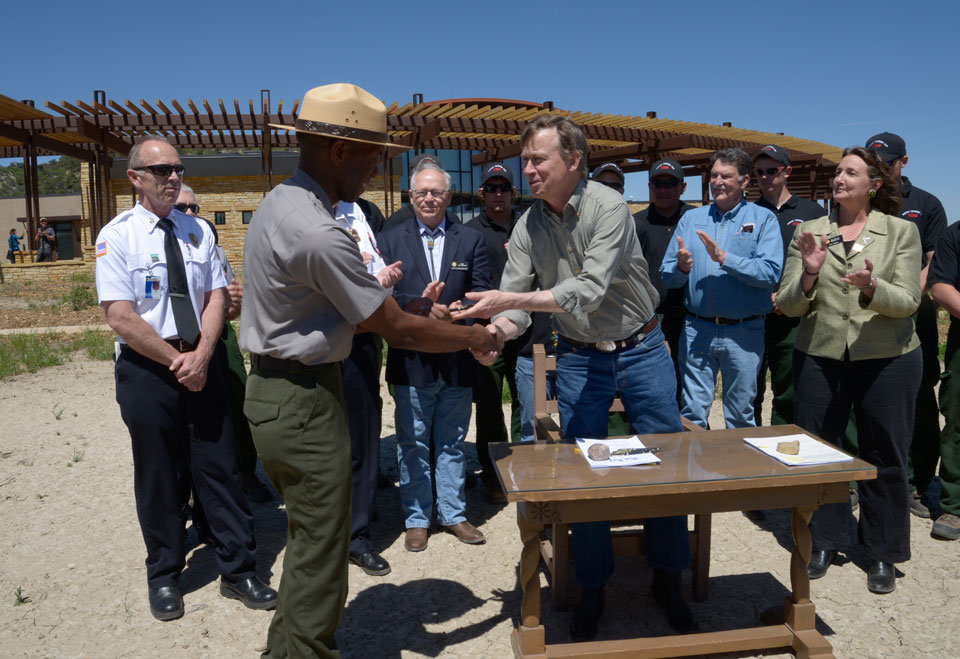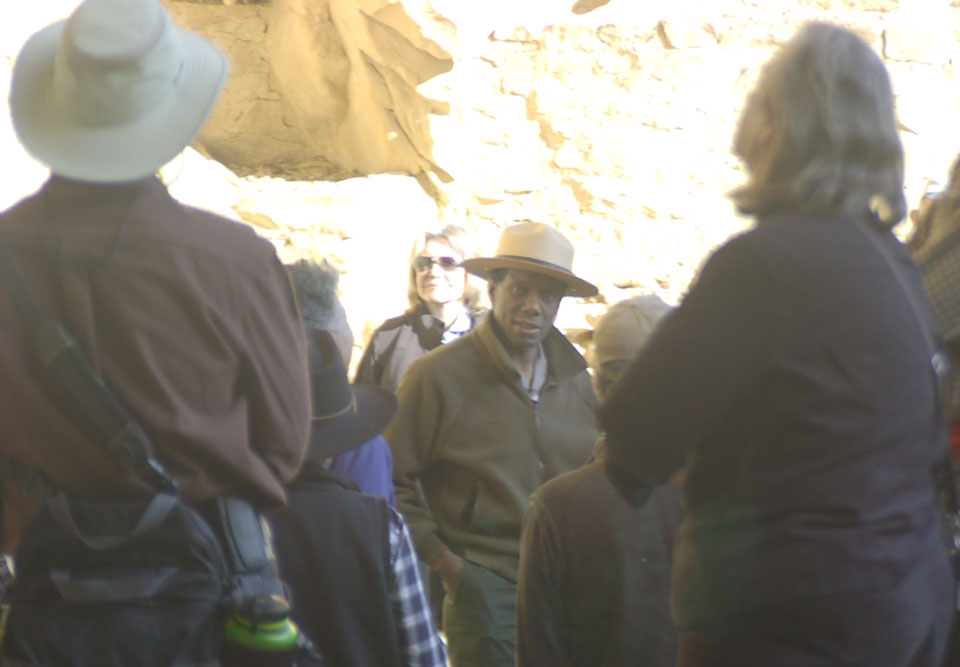Recreation Studies Led CSUN Alumnus on Trail to National Park Posts

Colorado Gov. John Hickenlooper presents a ceremonial pen to Mesa Verde National Park Superintendent and CSUN alumnus Cliff Spencer after the governor signed a wildfire funding bill at the park in June 2013.
Cliff Spencer had the epiphany that led him into wilderness work while riding on a city bus. A psychology student at California State University, Northridge in the early 1980s, Spencer was riding home one evening, wearing a CSUN sweatshirt.
“A woman asked me what I was studying,” said Spencer ’84 (Recreation and Leisure Studies), now superintendent of Mesa Verde National Park. “I told her, ‘psychology,’ and she asked me, ‘What discipline are you studying for?’ I didn’t have an answer for her.”
Growing up in Los Angeles, Spencer had worked at Griffith Park Boys’ Camp for years. He started out washing dishes in the kitchen and worked his way up to program director during his college years.
“All this time, I had been at the Boys’ Camp, working with campers and on the playground,” Spencer said. “Discussing it with Professor Jack Foley, I learned that there was more to recreation work than handing out balls on the playground. I learned that there was the whole community service aspect.”
Spencer switched his major to recreation and leisure studies, where Foley (now an emeritus professor) encouraged him to apply for a co-op program at the nearby Santa Monica Mountains National Recreation Area. He worked there while earning college credit, kicking off a distinguished career with the National Park Service.
Thirty years later, Spencer presides over the nation’s largest archaeological preserve as superintendent of Mesa Verde National Park and Yucca House National Monument in southwestern Colorado, a position he’s held since 2010. He also supervises the superintendent of Chaco Culture National Historical Park and Aztec Ruins National Monument in northwestern New Mexico.
As superintendent, Spencer said, his job is similar to that of a city manager.
“I manage all the division chiefs, as well as law enforcement, park interpreters and researchers,” he said. Mesa Verde is known for its ancient cliff dwellings, and 24 Native American tribes trace their lineage back to the park.
Previously, Spencer served as superintendent of Petrified Forest National Park in Arizona. He also has worked at Lake Mead, White Sands in New Mexico, Arizona’s Grand Canyon National Park and Coronado National Memorial, as well as Shenandoah National Park in Virginia.
His favorite? Point Reyes National Seashore in Northern California, where Spencer and his wife were married. The couple welcomed their daughter in nearby Santa Rosa.
“We have fond family memories of Point Reyes,” said Spencer, 55. Professionally, his work at Point Reyes included the beach and back-country hiking. He even managed ranch grazing permits inside the park. “I enjoyed talking to the ranchers and helping work out creative solutions for them while preserving park resources,” he said.
Spencer is one of just a handful of African-Americans in the upper ranks of the park service. He attributes the lack of diversity to the fact that besides Santa Monica Mountains and Golden Gate recreation areas, most national parks are in rural areas with few minority residents.
“The challenge is overcoming the belief that [minorities] wouldn’t fit in,” Spencer said. “That’s a myth. There’s more to working at a national park than your gender or the color of your skin. What I’ve found is that people in all of the parks are very welcoming.
“The park service has its bureaucratic side, but the nice part is that people really believe in the mission: protecting the resources and making them available to visitors,” he added.
Spencer credits his student work at Santa Monica Mountains — with Foley’s encouragement — with launching his park service career. The formative college experience included search and rescue, emergency medical response and the opportunity to earn his “red card,” a wildland firefighter certification.
“One day we were sitting in a meeting, and a wildfire broke out about 20 miles away,” Spencer recalled. “There were only two of us there who were qualified and had all of our firefighting gear in the trunk of our car. Always be prepared — that was the one thing I learned right away. It was scary at times, but also exciting.”
A Van Nuys High School graduate who also earned an associate degree from Pierce College, Spencer said he chose CSUN for its affordable tuition and proximity to home.
His favorite Matador memories include studying with Foley and former CSUN professor Michael Ego, who encouraged Spencer and his classmates to meet and network with L.A. city officials and other future colleagues.
“Jack Foley taught me to go out into the community,” he said. “At that age, you kind of wonder what you’re going to be doing the rest of your life. I really found a direction with recreation in general.”
As the National Park Service approaches its 100th anniversary in 2016, Spencer and his colleagues are working to entice younger visitors to discover their national parks. He’s also helping support a new internship program, launched this past summer, which attracts college students to work for the park service and other land management agencies. It’s a way to pay it forward, offering similar opportunities afforded Spencer in the Santa Monica Mountains and classrooms of Northridge.
“CSUN provided me with a really great, formative experience — to move forward in life and in my career.”


 experience
experience